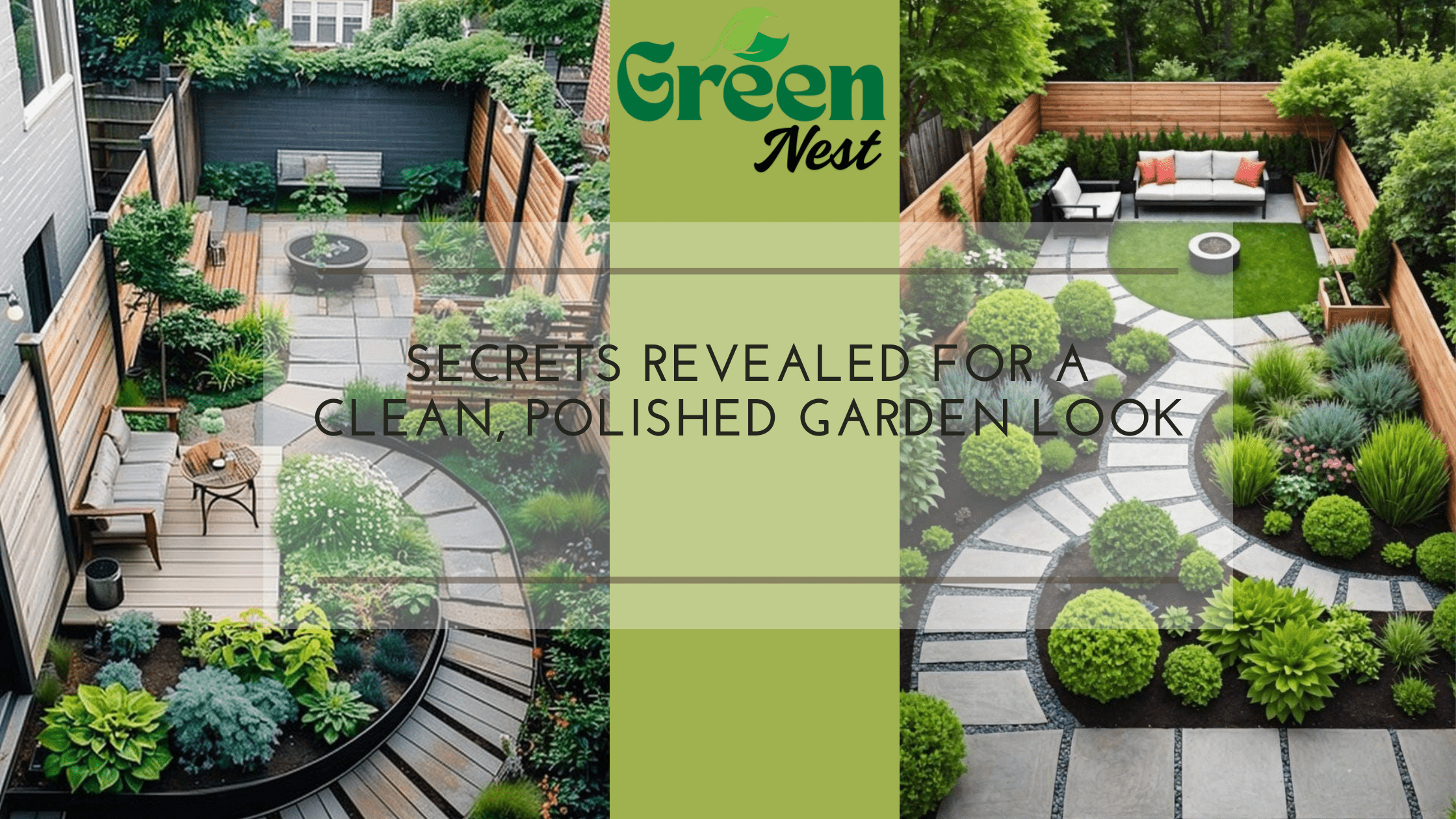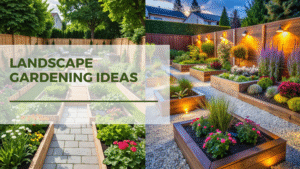Landscaping Edger Ideas: 5 Essential Designs for a Polished Look
When it comes to landscaping, the details matter just as much as the grand design. A meticulously planned garden can lose its charm if the lines are blurred, and the various elements spill into each other. One of the unsung heroes in achieving a pristine outdoor space is the humble Landscaping edger ideas. Often overlooked, this simple feature plays a pivotal role in creating a clean, organized, and visually appealing garden.
Whether you’re aiming to separate lush garden beds from pristine pathways, define the crisp edges of your lawn, or simply add an extra layer of aesthetic appeal, the right edger can make all the difference. In order to assist you determine which edger design can give your garden projects the desired polished edge—quite literally—we’ll go into great detail about each edger design, including its special advantages, best uses, and installation advice.
The Indispensable Role of Landscaping Edger Ideas in Design
Edging might seem like a minor detail in the grand scheme of landscape design, but its impact is remarkably profound. It’s the silent architect that brings order and definition to your outdoor sanctuary. Imagine a vibrant flower bed, overflowing with blossoms, but without proper edging, its beauty can quickly dissipate, bleeding into the surrounding lawn or path. Edging steps in to prevent this visual chaos, performing several vital functions:

- Delineation and Organization: Edging makes it obvious which parts of your landscape are flower beds, lawns, roads, and paths. The overall layout feels more purposeful and well-organized because of this distinction, which establishes order.
- Visual Interest and Aesthetics: Sharp, clean lines are inherently pleasing to the eye. Edging elevates your garden’s appearance from merely functional to exquisitely refined. It provides a visual break, drawing the eye along the contours of your design and adding a professional, finished look.
- Functionality and Simplicity of Maintenance: Edging has several useful advantages in addition to cosmetic ones. It serves as a physical barrier to prevent weeds and grass from growing in your garden beds, making upkeep chores like mowing and weeding much easier. As a result, you will have more time to appreciate your lovely garden and less time to deal with unwanted growth.
- Structure and Protection: Landscaping Edger Ideas adds physical barriers that can guide foot traffic, preventing accidental trampling of delicate plants. It also plays a crucial role in preventing soil erosion, especially on sloped areas, by holding soil and mulch within defined boundaries, even during heavy rains.
Table of Contents
Exploring Diverse Landscaping Edger Ideas and Options
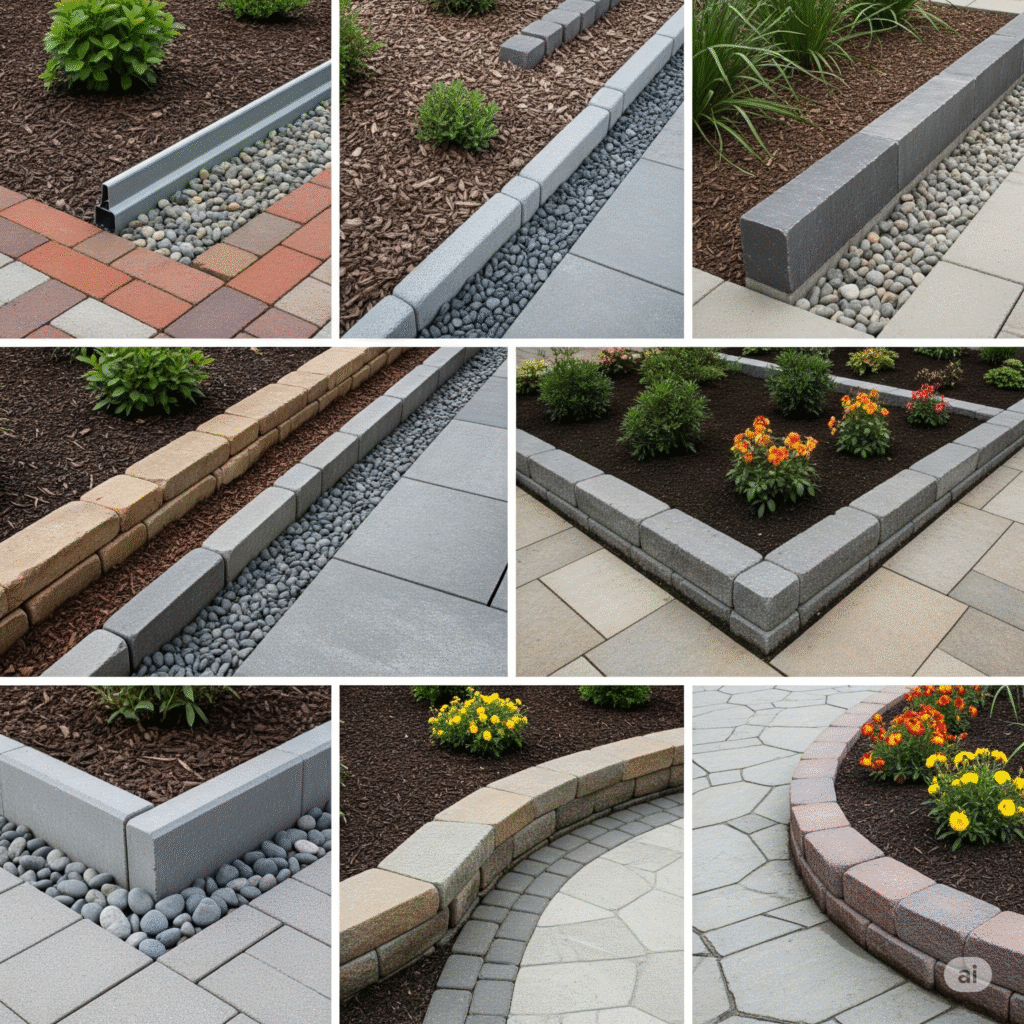
Now that we fully appreciate the significance of edging, let’s dive into some of the most popular and effective edger designs. Each material offers a unique blend of aesthetics, durability, and practicality, catering to different garden styles and budgets.
1. Brick Edging: Classic Landscaping Edger Ideas
Brick edging is a perennial favorite, known for its enduring appeal and robust nature. Its classic look effortlessly blends with a wide array of architectural styles, from traditional to contemporary.
Advantages:
- High Customization: Bricks are incredibly customizable due to their wide range of colors, textures, and finishes. To complement the exterior or garden color scheme of your house, you can choose earthy reds, subdued grays, or even multi-toned bricks. To provide a distinctive mosaic appearance, they can be arranged in a variety of ways, such as stacked horizontally, tilted vertically, or even in a pretty herringbone pattern.
- Outstanding Durability: Bricks are extremely durable, designed to endure the test of time, foot traffic, and weather variations. They provide a durable solution that needs little replacement once put correctly.
- Solid Barrier: Their substantial weight and interlocking nature provide a formidable barrier against spreading grass and invasive weeds, ensuring your garden beds remain pristine.
Pro Tip: For an especially unique touch, experiment with mixing different colors or orientations of bricks. Laying them on an angle, or alternating between horizontal and vertical placement, can create a visually dynamic and personalized edge that truly stands out.
2. Stone Edging: Organic Landscaping Edger Ideas
If your garden design leans towards a rustic, organic, or naturalistic aesthetic, natural stone edging is an unparalleled choice. It blends seamlessly with the environment, creating a harmonious and authentic feel.
Advantages:
- Beautiful Blending: Natural stones, with their inherent variations in color, shape, and texture, effortlessly integrate with the surrounding flora. They evoke a sense of timelessness and connection to nature.
- Endless Design Possibilities: Available in various shapes (from smooth river rocks to rugged flagstones) and sizes, natural stone offers infinite design possibilities. You can create a formal, tightly packed edge or a more informal, meandering border that follows the natural contours of your landscape.
- Outstanding Drainage and Erosion Control: Waterlogging in garden beds may be avoided thanks to the natural spaces and porous qualities of some stones. Moreover, larger stones effectively reduce erosion on slopes.
Best Uses:
- Around flower beds and perennial borders: Enhances their natural beauty.
- Defining ponds and water features: Creates a soft, organic transition.
- As decorative pathways: Large, flat stones can form stepping stones or an informal pathway edge.
3. Metal Edging: Modern Landscaping Edger Ideas
For those seeking a contemporary, minimalist, or subtly defined look, metal edging is an excellent choice. Materials like steel (especially Corten steel for a rustic, weathered look) or aluminum are particularly popular due to their durability and sleek profile.
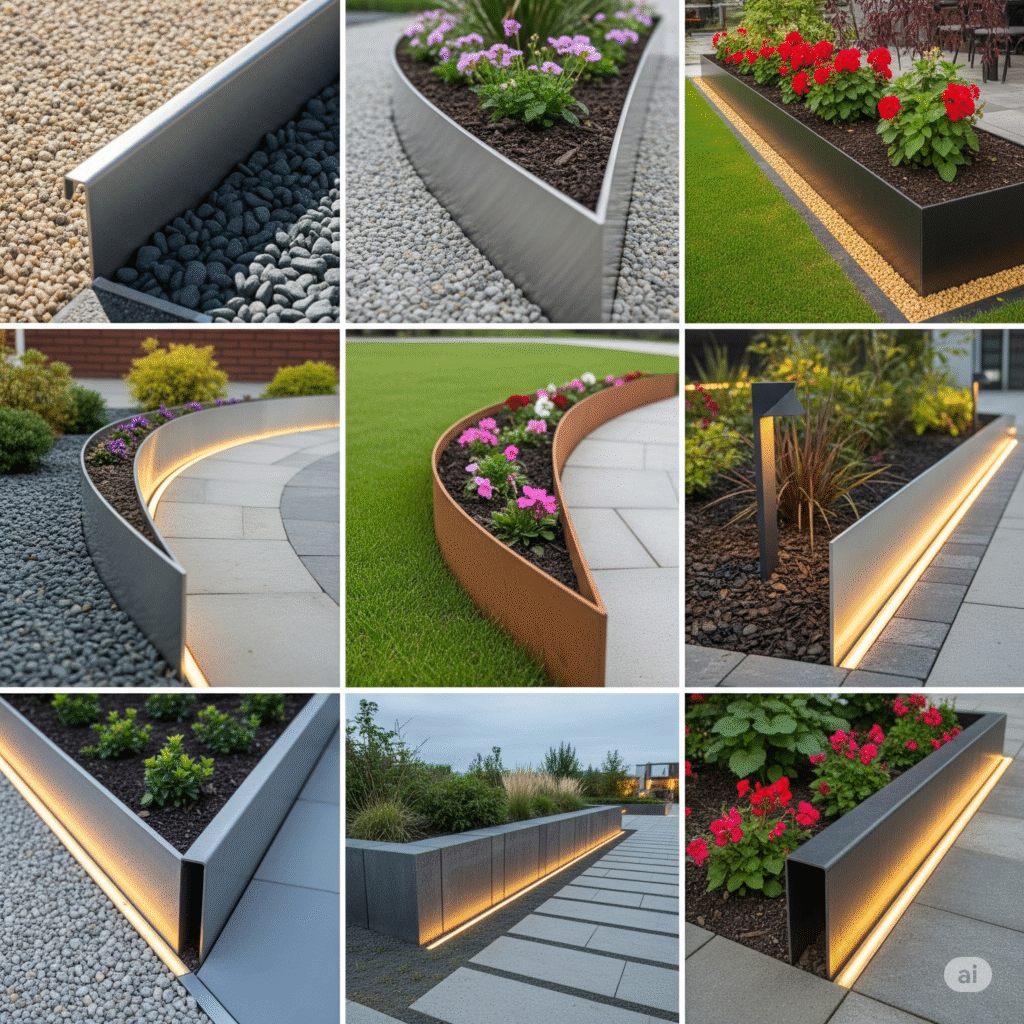
Advantages:
- Durable and Resistant: High-quality metal edging is extremely durable; it won’t rust, especially treated steel and aluminum, and it won’t crack, corrode, or decay with time
- Minimalistic Aesthetic: Its thin, unobtrusive profile allows it to blend into the landscape almost invisibly, providing a clean, crisp line without drawing excessive attention to itself. This makes it ideal for modern designs where clean lines are paramount.
- Simple to Install: In general, installing metal edging involves little disturbance of the soil. Its adaptability makes it suitable for a variety of garden forms by enabling exact angles and flowing curves.
Installation Tips:
- Use a rubber mallet for easier setup and to avoid damaging the metal or its coating during installation.
- Ensure the metal is inserted deep enough into the ground to prevent it from shifting over time and to provide a strong barrier.
4. Plastic Edging: Budget-Friendly Landscaping Edger Ideas
Plastic edgers are a highly popular choice, especially among DIY gardeners, due to their affordability, lightweight nature, and remarkable versatility.

Advantages:
- Lightweight and Easy to Install: Plastic edging is incredibly easy to handle and install, often requiring only a trench and a few stakes. This makes it a perfect weekend project.
- Variety in Heights and Colors: Available in various heights (from shallow to deep) and a range of colors (from black and brown to green), plastic edging can be selected to either blend in or create a subtle contrast.
- Exceptional Flexibility: Its most significant advantage is its flexibility, allowing you to create smooth, flowing curves and intricate designs that can fit almost any garden layout. This makes it ideal for irregularly shaped beds.
Considerations:
- Despite being less expensive, certain less expensive plastic alternatives may eventually become brittle from UV exposure, which might result in cracking or breaking. To increase lifetime, spend more on premium, UV-stabilized plastic.
- It may not offer as robust a barrier against aggressive grasses as more rigid materials.
5. Wooden Edging: Natural Landscaping Edger Ideas
For a truly natural, warm, and often more rustic look, treated wood edging is an excellent option. It brings an organic element to the garden, complementing existing timber features or a cottage garden aesthetic.
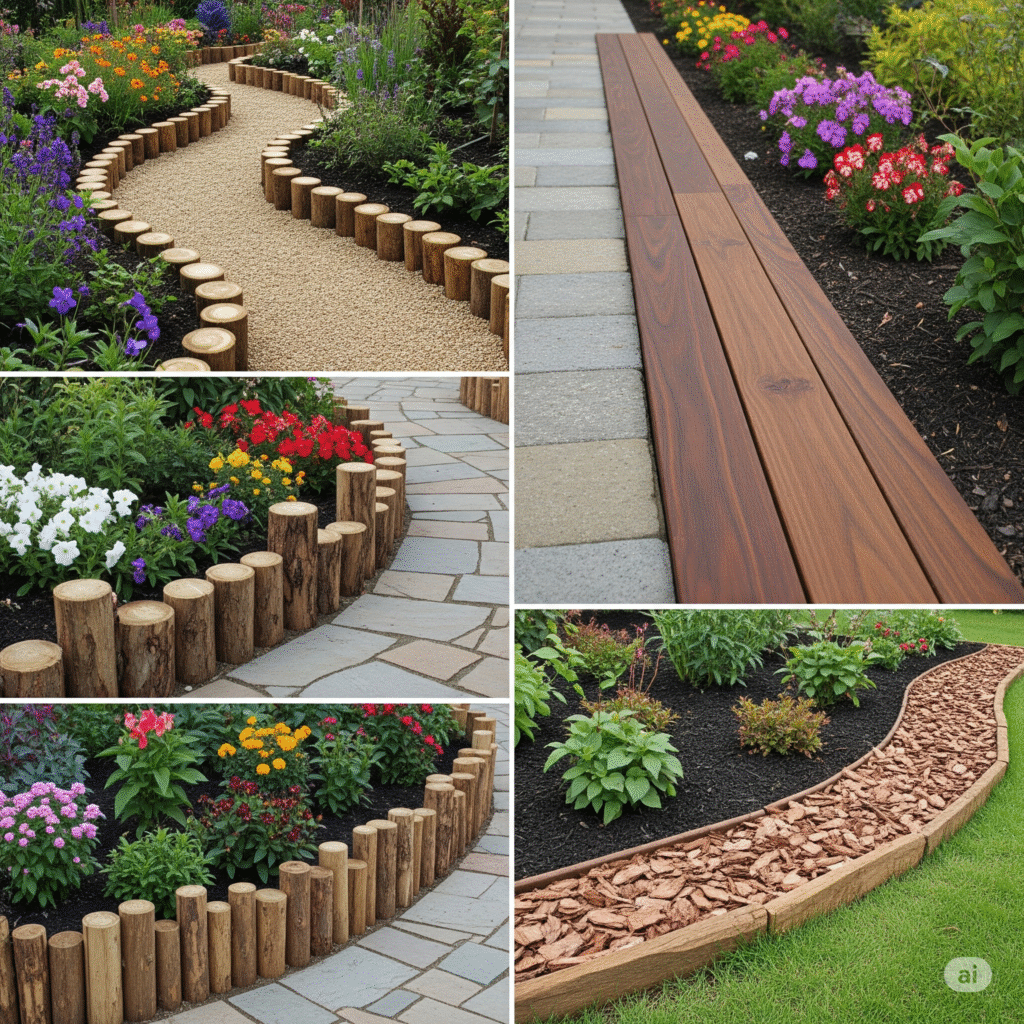
Advantages:
- Affordable and Eco-friendly: Wood is often more affordable than stone or metal, and if sourced sustainably, it’s an eco-friendly choice. Reclaimed wood can also be a unique and cost-effective option.
- Complements Garden Settings: Wood seamlessly blends with the natural textures and colors of a garden, creating a cozy and inviting atmosphere. It works particularly well in informal, cottage, or woodland-inspired gardens.
- Customizable: Wood can be cut to any length or height, and can be stained or painted to match existing designs or to create a specific visual effect.
Considerations:
- Longevity: The primary concern with wood is its susceptibility to rot, especially when in direct contact with soil. It’s crucial to use rot-resistant wood (like cedar, redwood, or pressure-treated timber) to ensure longevity. Even with treated wood, it may need replacement every few years depending on local climate conditions.
- Control of Pests: Wood occasionally draws pests. This can be lessened with routine examination and care.
Choosing the Right Landscaping Edger Ideas for Your Project
With so many great alternatives available, choosing the ideal edger might seem overwhelming. Take into account these crucial elements to make an educated choice:
- Assess the Landscape’s Style: Look at your garden’s overall aesthetic and the existing materials used in your outdoor space. Do you have a modern minimalist design, a traditional cottage garden, or a rustic natural setting? The edger should complement and enhance this style. For example, metal suits modern, brick suits traditional, and stone fits rustic.
- Assess Functionality Conditions: Choose between an edge that is only cosmetic, a strong barrier that keeps out grass and weeds, or one that has structural advantages like erosion prevention. A deeper, more rigid edger, such as brick or metal, may be better if your grass is aggressive. Shallow plastic or wood could be sufficient for simple visual distinction.
- Consider Upkeep Dedication: Certain materials need more maintenance than others. Even treated natural wood will ultimately decay and require replacement. Plastic may break easily. After installation, brick and metal often require relatively little upkeep. When choosing, consider how dedicated you are to maintaining your garden.
- Consider Your Budget: Edging materials vary significantly in cost. Plastic is generally the most economical, followed by wood, then brick, stone, and metal. Factor in not just the material cost but also potential installation costs if you plan to hire professionals.
- Installation Difficulty: If you’re a DIY enthusiast, consider the ease of installation. Plastic and many metal edgers are relatively straightforward for DIYers, while intricate brick or heavy stone installations might require more specialized skills or tools.
Essential Tools You Might Need
You’re right! Having the proper tools is essential for any successful landscaping edger ideas project. It not only makes the process smoother and more efficient but also ensures a professional, polished finish.
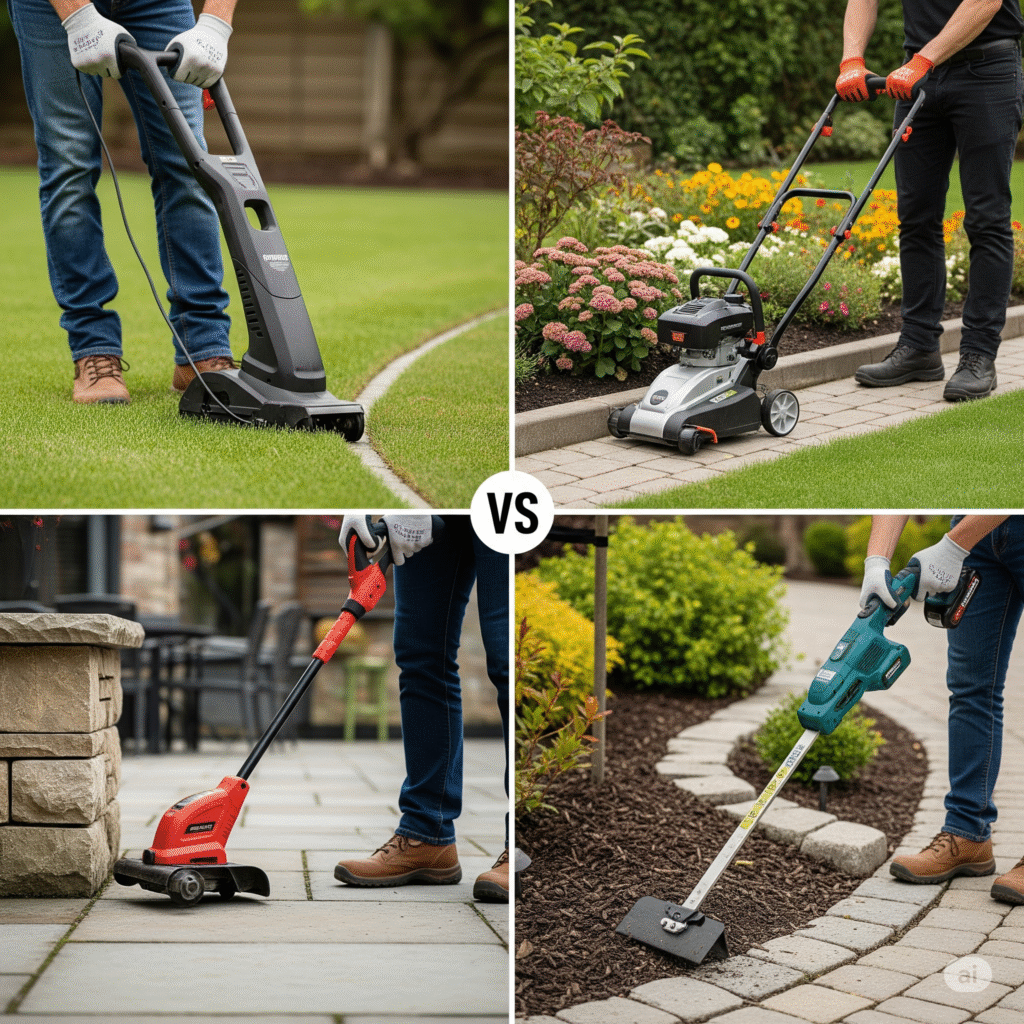
Here’s the expanded paragraph, incorporating the focus keyword and providing more detail on the tools:
- Garden Spade or Edging Tool: For digging the trench where the edger will be placed. An edging tool (a half-moon shaped blade on a long handle) is specifically designed for this purpose, creating clean, straight cuts.
- Hammer or Rubber Mallet: For gently tapping the edger into place, especially useful for metal or plastic stakes and securing bricks.
- Level: To ensure your edging is perfectly horizontal and creates a consistent line, especially crucial for brick or block edging.
- Measuring Tape: For accurate placement and determining material quantities.
- String Line and Stakes: To create a perfectly straight or gently curving guide for your trench.
- Gloves: To protect your hands from soil, sharp edges, and potential splinters.
- Landscape Fabric (Optional but Recommended): While edging helps, laying a strip of landscape fabric beneath your mulch in the garden bed can provide an extra layer of weed prevention, further simplifying maintenance.
Maintaining Your Landscaping Edger Ideas for Lasting Beauty
No matter which type of edging you choose, regular maintenance is key to preserving its clean, polished look and ensuring its longevity. Even the most durable landscaping edger ideas benefit from a little attention.
Here are some essential maintenance tips:
- Regular Weeding: Despite the barrier, a few persistent weeds might still pop up along the edges. Keep your edges tidy by pulling these weeds as soon as they appear to prevent them from taking root and becoming harder to remove.
- Trimming Grass: If your edging borders a lawn, use a string trimmer (weed wacker) or a dedicated edger tool to keep the grass from encroaching on your flower beds. This creates a crisp line between the lawn and the edging material.
- Refreshing Mulch/Soil: Over time, mulch or soil in your garden beds can settle or wash away. Periodically add new mulch or top up the soil to keep it level with your edging, maintaining its effectiveness and aesthetic appeal.
- Repairing Damage: Inspect your edging regularly for any signs of damage. Replace rotting wood sections, fix broken bricks, or re-secure loose metal/plastic pieces as needed. Addressing small issues promptly prevents them from escalating and maintains a tidy appearance.
- Cleaning: Depending on the material and your climate, edging can sometimes accumulate dirt, moss, or algae. A simple scrub with a brush and water, or a gentle pressure wash, can restore its fresh look.
Conclusion: The Power of the Polished Edge
Incorporating the right edging into your landscape design is a simple yet profoundly effective way to enhance both the beauty and functionality of your outdoor space.
It transforms a good garden into a great one, offering crisp lines, organization, and simplified maintenance. With a wide array of landscaping edger ideas ranging from the classical elegance of brick and the organic charm of natural stone to the sleek modernity of metal, the versatility of plastic, and the natural warmth of wood, there’s an edger design perfectly suited for every garden style and budget.
So, next time you’re planning a landscaping project, or simply looking to refresh your existing garden, don’t overlook the transformative power of the edge. It’s an investment in detail that yields significant returns in visual appeal and practical benefits. It’s time to sharpen your landscape’s appeal and enjoy the pristine beauty of a truly polished garden!
What experiences do you have with edging? Share your favorite edging materials or innovative designs in the comments below, and let’s inspire each other to create even more beautiful gardens!
For more gardening tips and landscaping secrets, check out Gardenista and Better Homes & Gardens for a wealth of ideas and inspiration.

